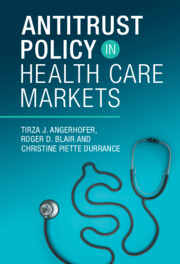Book contents
- Antitrust Policy in Health Care Markets
- Antitrust Policy in Health Care Markets
- Copyright page
- Dedication
- Contents
- Figures
- Tables
- Acknowledgments
- Table of Cases
- 1 Health Care Markets and Competition Policy
- 2 Antitrust Policy in the United States
- Part I Monopoly
- Part II Seller Cartels
- Part III Monopsony
- 11 Monopsony, Dominant Buyers, and Oligopsony
- 12 Countervailing Power
- 13 Group Purchasing Organizations, Monopsony, and Antitrust Policy
- Part IV Buyer Cartels
- Part V Mergers and Acquisitions
- Index
- References
13 - Group Purchasing Organizations, Monopsony, and Antitrust Policy
from Part III - Monopsony
Published online by Cambridge University Press: 24 November 2022
- Antitrust Policy in Health Care Markets
- Antitrust Policy in Health Care Markets
- Copyright page
- Dedication
- Contents
- Figures
- Tables
- Acknowledgments
- Table of Cases
- 1 Health Care Markets and Competition Policy
- 2 Antitrust Policy in the United States
- Part I Monopoly
- Part II Seller Cartels
- Part III Monopsony
- 11 Monopsony, Dominant Buyers, and Oligopsony
- 12 Countervailing Power
- 13 Group Purchasing Organizations, Monopsony, and Antitrust Policy
- Part IV Buyer Cartels
- Part V Mergers and Acquisitions
- Index
- References
Summary
Hospitals use group purchasing organizations (GPOs) to purchase medical supplies, devices, and other inputs rather than purchasing directly from a manufacturer. GPOs consolidate the purchasing power of their members and negotiate contracts with input suppliers on their behalf. But this has raised several public policy concerns. First, in order to be successful in reducing input prices, a GPO must represent a sufficient volume of purchases and therefore has some measure of monopsony power, which tends to reduce social welfare. Second, GPOs employ a variety of contractual provisions that may limit the sources of supply to their members, which raises antitrust concerns about the exclusion of equally efficient competitors. Third, the GPO’s funding mechanism may provide a perverse incentive such that GPOs may not secure the best price for hospitals when it is profitable to do so. This chapter provides an economic analysis of the competitive consequences of GPOs and addresses the economic effects of the GPO funding mechanism.
- Type
- Chapter
- Information
- Antitrust Policy in Health Care Markets , pp. 300 - 322Publisher: Cambridge University PressPrint publication year: 2022

